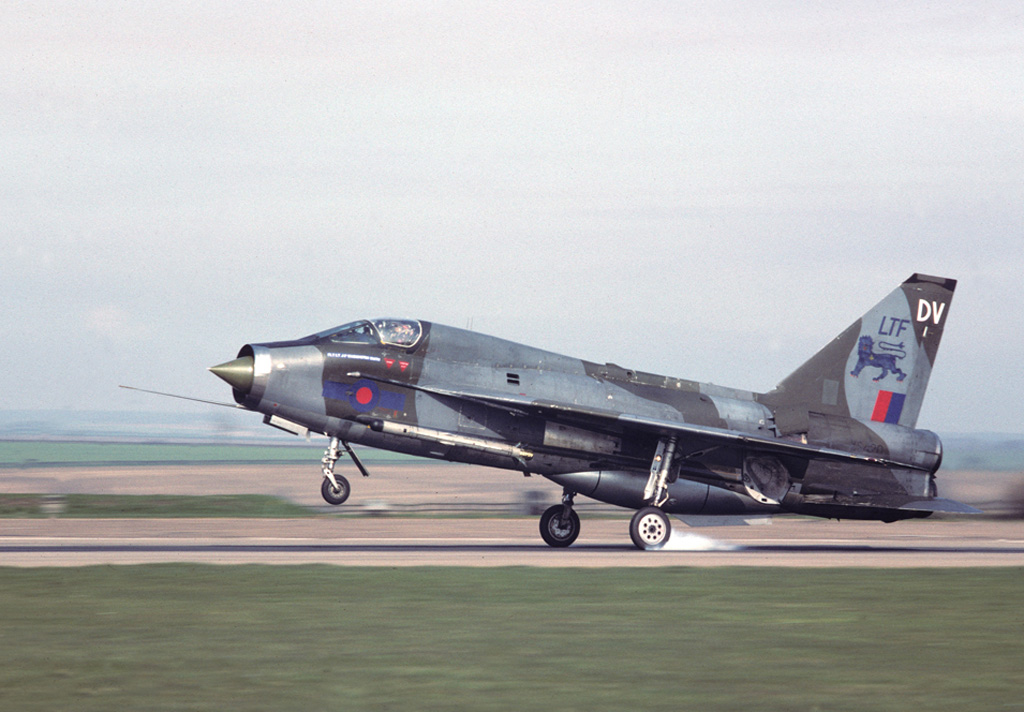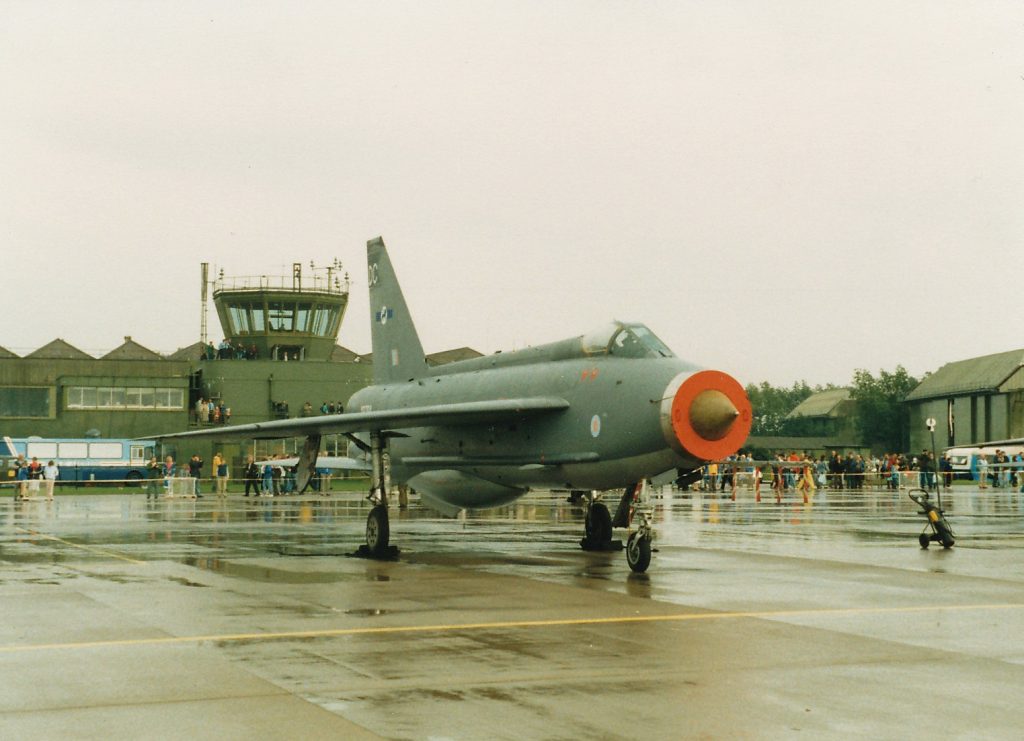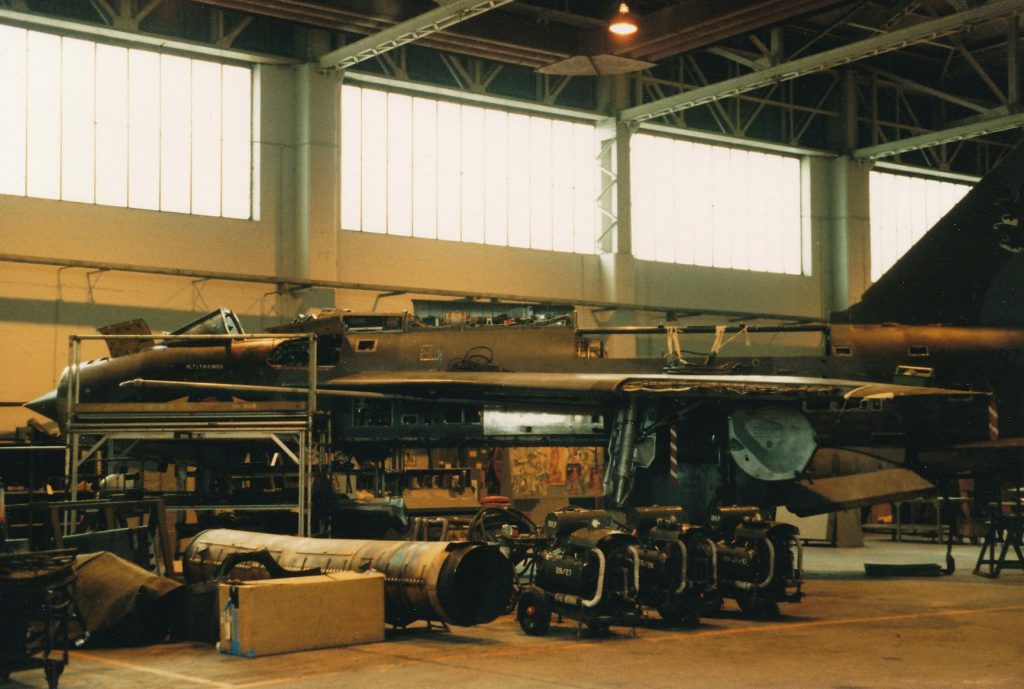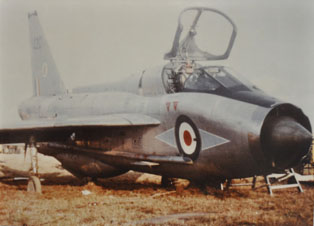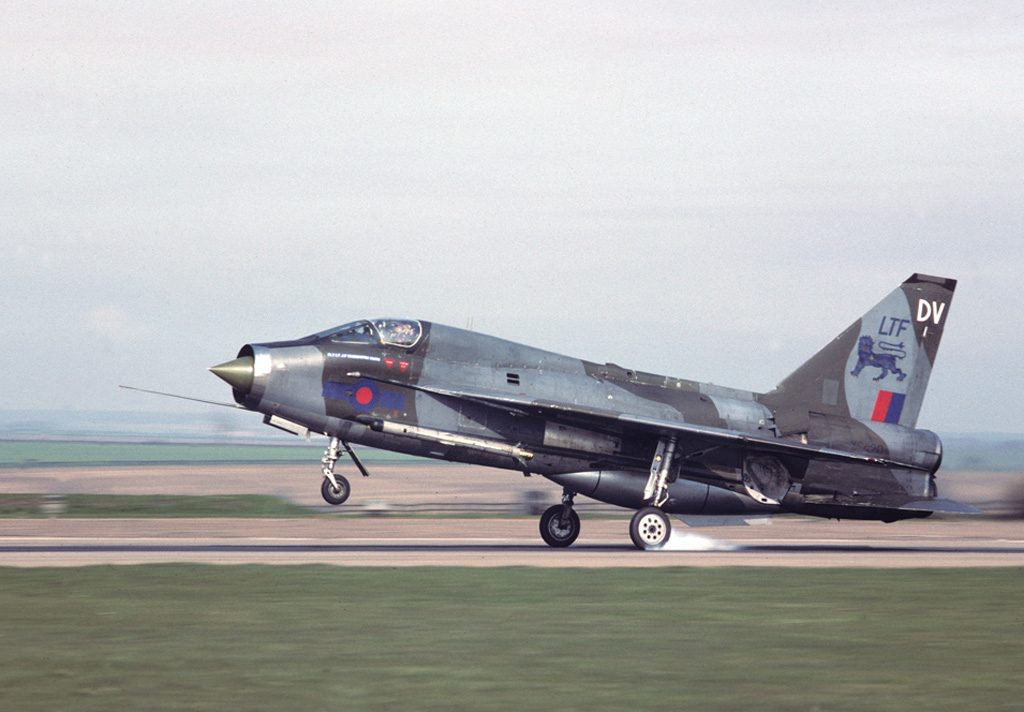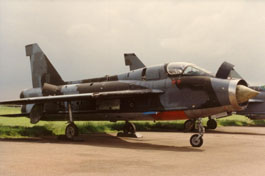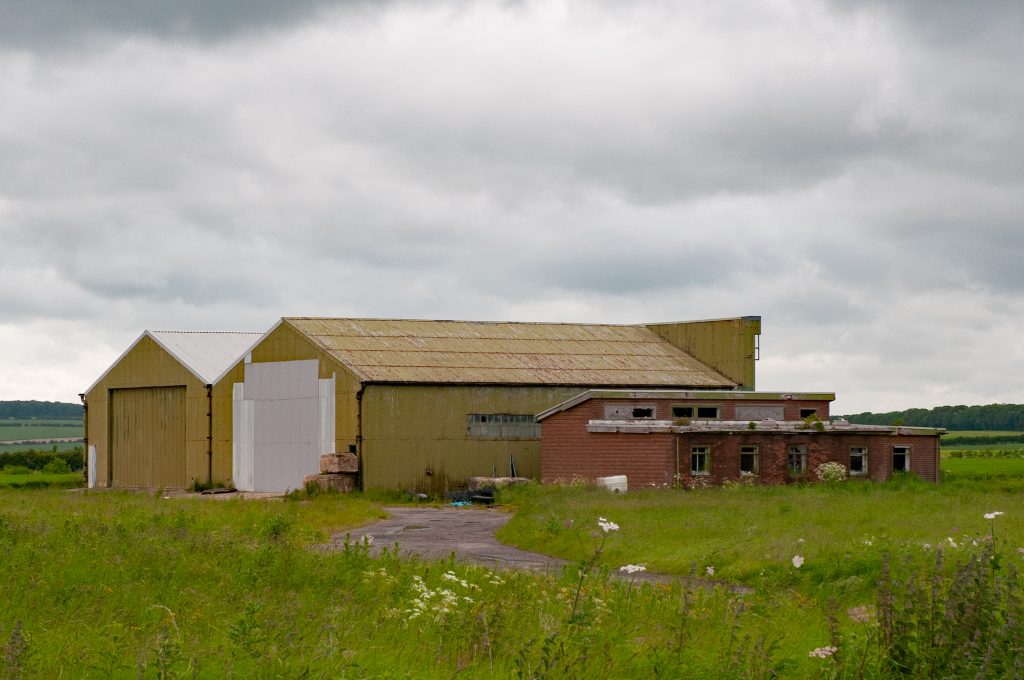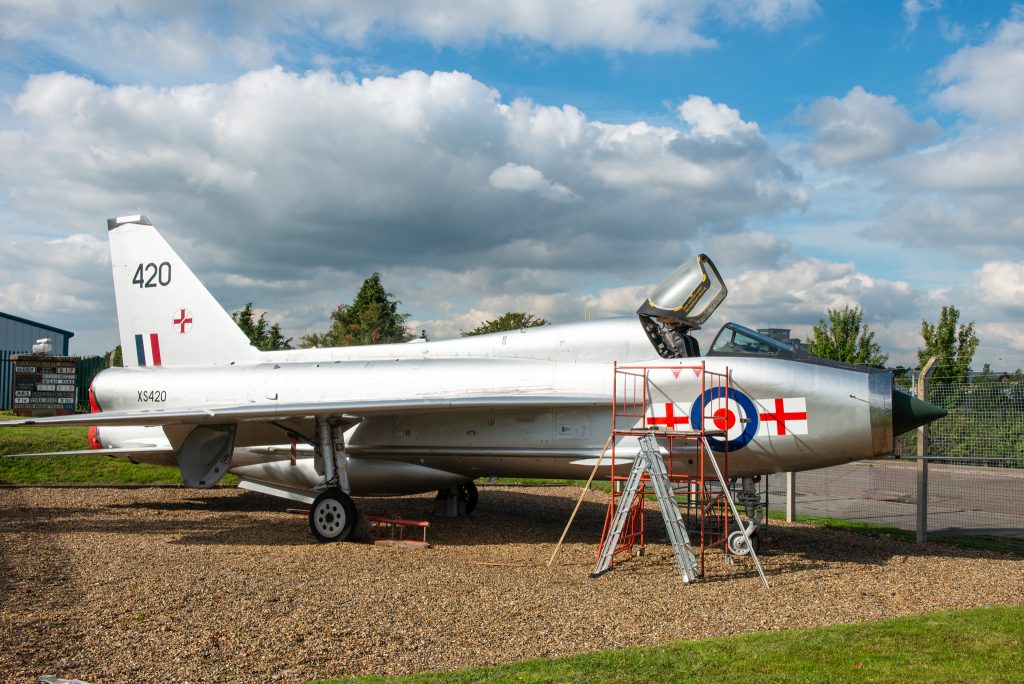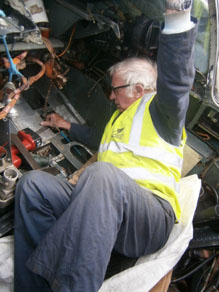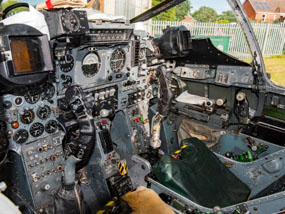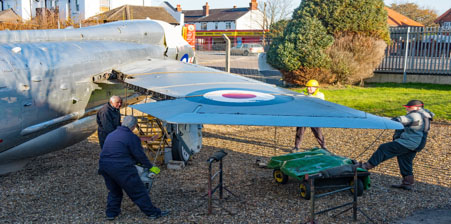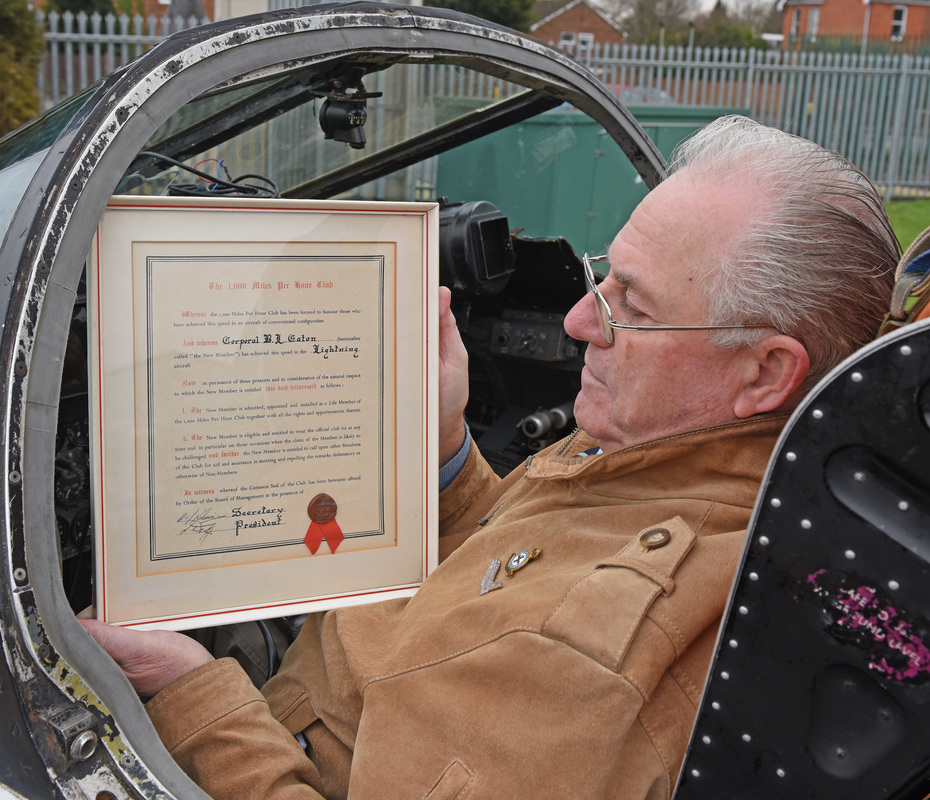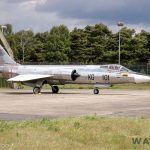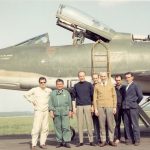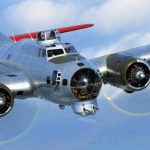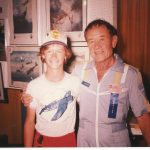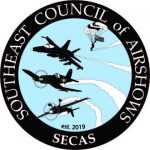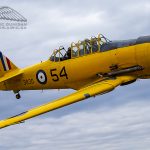Your Stories is a collection of memories we have received from our readers and adapted as articles to share on this website. If you are interested in sharing your own memories or stories with us, please contact us HERE
By Richard Hall via Flying Graphics
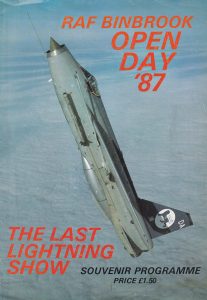
The conditions were somewhat apt on this day as after all the Lightning was an all-weather interceptor, but the climate was certainly trying the patience. Never mind though we’d arrived so we were going to make the best of it. At the time it didn’t seem like much fun but as the rose-tinted glasses of time changed the perspective, it was agreed the day was one of the best we had ever experienced. Others I’ve met since who attended on the day say a similar thing and they too wouldn’t have missed it for the world.
Binbrook has a rich history and was one of the last Expansion airfields to be built, opening in June 1940. Notable for its contribution to Bomber Command operations in World War Two, the airfield became the parent station of 12 Base for 1 Group with the Avro Lancasters of 460 Squadron (RAAF) arriving in May 1943. The squadron was to have a hard time in its operations over Europe, losing 130 Lancasters with another 30 written off in crashes, this was to be the highest loss sustained within the Group. Post war the airfield was to enter the jet age with the arrival of English Electric Canberras and Gloster Javelins, it was also to become home to the RAF’s last remaining Lightnings.
The Lightning is an icon among aviation enthusiasts and to see one perform at an airshow was quite something to behold, the sheer power, noise and agility was when once seen never to be forgotten. So, to be given the chance to see a Diamond Nine formation flown in marginal conditions was a truly awe-inspiring prospect. Observing the Nine forming up was a marvel in set piece aerial choreography, as one Lightning powered down the runway in reheat, another came across at a 90-degree angle over the top, I’d not seen anything like it before and for that matter, nothing like it since. Also, who will ever forget, if they witnessed it, the singleton’s low-level high-speed centreline run on the day and the ensuing condensation cloud that enveloped the aircraft’s fuselage? What a performance, the likes of which we will never again see in the UK.
Away from all the action and to afford some protection from the rain for the bedraggled spectators, a number of the hangars were open. The Lightnings within were either stored or being subject to routine maintenance. Inside Hangar 3, one F.6, XR769, was having work done, but who was to know that in just under eight months’ time the aircraft would be at the bottom of the North Sea. On 11 April 1988 it was being flown by Flt Lt Dick Coleman (RAAF) when an inflight fire forced him to eject. The event was witnessed by Ian Black flying in another Lightning and a recording of the audio exchange between the two pilots is available on You Tube, it’s well worth a listen, click HERE.
I’m not sure if Hangar 5 was open on the day, but within here T.5 XS420 was stored. If I’d known then what impact this aircraft was to have on me two and a half decades later, I would not have believed you. I was within meters of meeting up with a future project, but in this instance, it was not to be, the first meeting would not be for many years yet to come. Lightning T.5 XS420 was constructed at Warton and first flew in the hands of D M Knight on 23 January 1965, following this it was assigned to 226 OCU at Coltishall arriving there on 29 April of the same year. While here the aircraft was to suffer an accident, which could have seen the end of its career. On 31 January 1973 a reheat malfunction to one engine resulted in a failure to become airborne and a subsequent aborted take-off. Contemporary photos show the T.5 had run off the end of Coltishall’s runway and had buried its undercarriage in the dirt, the aircraft was deemed Cat 3R but was subsequently repaired.
It remained at Coltishall until September 1976 before a move came to the Aircraft Storage and Support Flight at Binbrook. The T.5 stayed at the airfield for the remainder of its service life and flew with 5 Squadron and the Lightning Training Flight before retiring in May 1983 with 2,296.55 hours on the clock. It then went into storage before eventually being dumped out on the airfield following spares recovery, ready for disposal.
The last unit in the RAF to fly the Lightning was 11 Squadron who retired their mounts on 30 April 1988. A handful of Lightnings continued to fly trials in connection with the AI.24 Foxhunter radar, but these were taken out of service in late 1992. XS420’s charmed life was to continue as thankfully it was purchased privately into preservation, leaving Binbrook in July 1988.
The airfield itself closed finally in July 1992 and over the subsequent years has become a shadow of its former self. The runways and taxiways have been torn up, the Control Tower demolished and many of the buildings, including the hangars converted to other uses. I’ve been back many times in recent years, but my mind is unable to compute the visit of 1987 to what remains now. Strange to say its like I never went there all those years back as the place is now so different, but I must have as I still have the photos. I find all this very odd but I’m sure others may have similar thoughts as something that we all once took for granted has now changed beyond all recognition, anyway enough of the deep thinking and on with the story.
So, the usual question from those who visit XS420 is, “how did you come to own a Lightning?”
Well, put it this way, it was not something that was on the bucket list. The original plan was to acquire a Lightning cockpit, but as with all such schemes, unexpected events come into play. Mike for some years had wanted to obtain a cockpit to take as a travelling exhibit to airshows. He asked me if I wanted to be involved and I agreed it would be a nice idea. Mike set about finding a cockpit and a Lightning F.53 ZF582 located at Bournemouth Aviation Museum seemed like an option. Negotiations took place but to cut along story short, they failed. On the day I received the news that the plan would not go ahead I was visiting the Yorkshire Air Museum Elvington. Mike texted me to advise the museum did not want to sell, to say the least I was gutted, my thoughts were that we would never get another chance to acquire a Lightning cockpit.
I was staying in Lincolnshire over-night and as I drove back to the B&B I passed near Binbrook, so I decided to visit the airfield and walked out to the QRA sheds. As I stood on the last piece of Runway 04 that remained, I looked out over the approach and thought, ‘that’s another dream gone’, but little did I know what was about to transpire.
The next day on 17 June 2012 I went to Cockpit Fest at Newark Air Museum and was talking to a chap about the failure to obtain ZF582’s cockpit. He told me there was an exhibitor who had a Lightning for sale at the event and I should go and take a look. Sure enough there was a board showing T.5 XS420 as being up for grabs so I spoke to the owners, their names, Neil and Heather Airey of Lakes Lightnings. Neil informed me XS420 had only been put on the market that very weekend and I had been the first to show an interest. Not believing my luck I spoke to Mike and asked how he felt about owning 50% of a whole Lightning. At first, he seemed a little hesitant but when I asked him what the chances were of obtaining a complete airframe, in good condition, at reasonable cost and located 30 miles from home at Farnborough, his view changed. This ultimately ended up with Mike and I being the proud and rather bewildered owners of one of the Cold War’s most iconic aircraft.
The pair of us set to work on XS420 as there was a fair amount of cosmetic restoration that needed to be done. Mike also looked into obtaining parts for the cockpit as when the aircraft was acquired, it was empty save for two ejection seats and the port rudder pedals. As time progressed however, Mike decided he wished to pursue other projects which led to me taking sole ownership of the T.5 in May 2013. It was now time to start looking at some of the more serious work that was required to conserve and maintain the aircraft.
Lightnings do not travel well in anything other than air so when XS420 was moved by road from RAF Binbrook, the wings were cut off to make transportation possible. It is feasible to dismantle the airframe so that the wings can remain intact, but in this instance, they were subjected to the cutter’s wheel. The T.5 then went through several owners but was eventually purchased by Murray Flint who began the task of stripping it back to a natural metal finish. During his ownership he was approached by the RAF who enquirer if the Lightning could be displayed at the Royal International Air Tattoo Fairford, that in 2003 would celebrate 100 years of flight. In return for the loan, the RAF arranged for Serco to repaint the aircraft at Cranwell into an all silver scheme similar to the bare metal finish it sported upon first entering service in 1965. At the conclusion of its static display appearance at Fairford, XS420 moved to Farnborough Air Sciences Trust (FAST) and was in due course sold to Neil and Heather Airey.
Following the aircraft’s arrival in 2003 a repair was made by laying thin metal plates over the cuts in the wings, these were to remain in place for the next 10 years. A neater way of doing this needed to be found so I decided to fabricate plates that could be slotted into the wing’s upper surface. Six 5mm thick aluminum plates were required, three per wing, and these were hand cut by jigsaw from one large sheet. The pieces were then filed to match the profile of the cuts. This was a long, tedious job as the cuts were very ragged, which entailed a great deal of filing, swearing (and blisters) until a good fit could be achieved. The panels when finished were then drilled, tapped and screwed into position. One of the major milestones for the aircraft was achieved in October 2013 when the cockpit was opened for the first time in many years. Initially the canopy was lifted with some gentle persuasion as it was found that part of the locking mechanism had seized. Once freed off it took four FAST volunteers to lift the canopy and to secure it in the open position. At a later date a hydraulic pump was externally rigged up enabling pressure to be applied to the canopy ram which lifted with no problems.
This was a testament to British engineering as it is unlikely that the ram had been under pressure for over 20 years and it worked flawlessly. A self-contained hydraulic pump has now been fitted in the avionics bay behind the cockpit, which allows the canopy to be lifted with a minimum of effort. A genuine canopy jack lock was also obtained to ensure that the cockpit could be safely worked upon when the canopy is open. The cockpit itself had had most of the items removed prior to the aircraft’s arrival at FAST. The ejection seats were still in place, minus rails, but the instrument panel, main crates and most other items were missing, so there has been an on-going search to locate parts. Aerojumbles, e-Bay, people’s garages and lofts have all yielded results. The Lightning preservation community are a close-knit group and there has been help on hand to obtain parts and gain information which has proofed to be extremely useful. There has been help from the Lightning Preservation Group who supplied a starboard radar hand controller and Dave Tylee from the Gatwick Aviation Museum, who sourced a number of wing panels that have allowed those cut to be replaced. There has also been assistance from many other sources and individuals. But one item missing was the main instrument panel which was harder to obtain than the proverbial hen’s teeth. In order to overcome this, it was necessary to have a new panel made from scratch. Access was available to a genuine T.5 panel, and this was used as a pattern to fabricate an exact laser cut replica.
When completed the panel was tried for size in the cockpit and was found to fit perfectly with all the fixing points lining up. The panel was spray painted to the correct colour of dark sea grey, with all the lettering that was present on the original being etched onto the replacement. Most of the instrumentation had been obtained for refitting but there was another major piece missing, the crates which hold the aircraft’s Direction, Attitude and Height/Rate of Climb instruments. With the crates missing, a new set were fabricated from scratch by a local engineer who had built similar items before for other Lightnings.
One problem with a T.5 in being a two-seat trainer is that some cockpit equipment is duplicated and also handed. This situation compounds the issue of obtaining parts as there were only 22 T.5s built, but on the whole the hunt has been successful albeit spread over a long period of time, patience is certainly a virtue when restoring an old aircraft. One man who has patience in abundance is former RAF Crew Chief, Derek Parks who until recently undertook much of the work of rebuilding XS420’s cockpit. In order to get the panel, crates and ejection seats refitted, missing floor panels required fabrication, luckily for Derek the T.5 cockpit is a little bigger than that of a single seater. I’m told working within for instance an F.2A cockpit is like being trapped in a car boot, but nonetheless seeing Derek squashed into the confines of the T.5 certainly gave me cause for great respect.
With the floor back in, he then installed the panel, crates, instrumentation and seats, a painstaking job indeed, just remember this when you read what is to come a little later on. Aside from cockpit work as part of the ongoing maintenance regime fuselage panels are being regularly removed to free off and grease DZUS fasteners. On the rear of the panels there are often serial numbers of Lightnings other than XS420. Several long-lost members of the family have been found living on in a small way within the aircraft. One panel came from Lightning F.3 XR715 which crashed way back in 1974.
A couple of panels have been found to be from aircraft that have made it into preservation elsewhere. It is very much hoped that the current owners of these airframes won’t want their panels back as it could leave XS420 with a few difficult holes to fill. One thing I’ve learnt with regards to the restoration of old aircraft is that when you’re looking for parts they never appear and when you least expect it, they do. Who was to know that after Derek had refitted XS420’s replacement instrument panel that the original one would come up for sale? There was no hesitation on my part in acquiring the piece, as the chances of another one appearing was practically nil. It was therefore with a little trepidation that on one day I said to Derek, “what kind of mood are you in?” “Why?” he says, “well you know all that work you’ve undertaken in fitting the new panel?” “Yes”, he retorts, and while standing at a safe distance I respond, “how do you feel about doing it all again?” Luckily, he was in a good mood and he duly removed the fabricated panel and replaced it with the original and all the instruments, no mean feat and several weeks work. You would think there would not be much call for a second-hand non-genuine Lightning T.5 panel, but you’d be wrong, it sold to a chap within a week, who was creating his own cockpit section from scratch.
With the acquisition of the panel a number of other very important items also came with it, not least the starboard throttle, which is unique to the T.5, various components that were not available elsewhere and a multitude of instruments. It’s strange as parts will often come out of the blue, one such occasion was when I was attending the Yeovilton Air Day in July 2015. Watching the display, the mobile phone chimes to say there is an e-mail the contents of which asks if I would be interested in purchasing a T.5 Instructor’s stick top (starboard). The port stick top (I do have one) is rare but do occasionally come up on e-Bay, but the Instructor’s is fairly much never seen for sale. I didn’t need asking twice, responding in the affirmative and the top was duly purchased, another very rare part of the jigsaw had fallen into place.
A similar situation also occurred while I was at RNAS Culdrose Airshow in 2016, when a phone call came through saying a T.5 engine start panel was available, again this is an extremely elusive part, I’ve only seen one available outside of a Lightning cockpit and that’s the one I now have. The housing for this panel was missing from XS420 but in 2019 one came on the market and has also been obtained, again it’s the only one I’ve ever seen for sale.
Not all work has been focused on the cockpit, since arrival at FAST in 2003, XS420’s flaps had been in the deployed position, where when on the ground they should be stowed retracted. I wanted to address this; the port flap was not much of an issue as it could be pushed into the up position where it stayed in place (something to do with hydraulic lock I’m advised).
The starboard was a different matter entirely as on the inboard end there was no bracketing or ram, this had all been lost when the aircraft’s wings were cut off years ago. The flap had to be taken off to affect a repair, this necessitated the removal of some of the upper and lower wing panels. These had not been removed in decades and the panels were held in place by hundreds of screws, many of which were inevitably seized. Derek came up with an ingenious tool that allowed practically all the screws to be undone, so they could be reused to refasten the panels at a later date. The flap was duly removed with help from fellow FAST members, new bracketing was fabricated, it was then refitted and held in place by Acro props while the final attachments were made to allow it to hold its own weight in the up position.
This was not as easy as it sounds as the flap not only had to be supported in weight, but there was also a requirement to retract it. To achieve a satisfactory outcome a 16mm threaded bar and heavyweight lifting eye (0.8 tonne SWL) was attached to the original fixings on the flap. In essence the bar and eye acted as an artificial jack which was used to pull the flap into the correct position, it also allowed for fine adjustment to ensure it was correctly aligned with the wing surfaces. With the conclusion of the works to the flap, the task was then to reinstate all the wing panels together with their fixings. Once this was done, it allowed for the preparation and painting to the upper wing root plates, which had previously been fitted some years ago. The completion of this major work has considerably tidied up XS420 and has helped to improve the aircraft’s overall appearance.
One of the areas of importance with the T.5 was to give the aircraft a bit of life, a way to achieve this was to reinstate the navigation, landing and anti-collision lights. It was decided that a new 12-volt DC system would suffice to give the desired effect. The existing 28-volt DC wiring was in poor order, so new cables were run in to serve the outer wings, undercarriage legs, rear fuselage and spine.
The system was powered using a 240-volt AC to 12-volt DC inverter, with the wing tip and spine anti-collision lights served by a custom-made flasher unit. The external lights on a Lightning are not that spectacular compared to some other aircraft, nonetheless when energized they do create a pleasing spectacle, especially as the light fades on a winter’s evening.
There are now plans afoot to power up the lighting in XS420’s cockpit, with the help of Al Stepney who has undertaken a similar project to Hugh Trevor’s Lightning F.2A (XN726), located at the Boscombe Down Aviation Centre, Old Sarum. In the first instance there are a large number of P Lights located on the instrument panel of a Lightning and many of these were missing. This is where modern technology came into play and Al arranged for replacement lights to be 3D printed. In due course the components were delivered and are indistinguishable from the genuine item. The lighting will be powered by a 24-volt inverter and will feature the use of LEDs, to keep heat and power consumption low. In order to supply power, cables were run from the cockpit to a source located in the nearby shed. Installing these cables was one of the most unpleasant jobs I’ve undertaken on the aircraft, as to achieve this entailed crawling internally the length of the fuselage. Never have I encountered so many sharp edges, sticky surfaces and places to bang your head, thank goodness for the invention of the bump cap is all I can say.
It has been some years since XS420 was painted, 16 to be precise and overall, the finish is bearing up well. However, while the paint is holding up, the lacquer is suffering from the effects of sunlight on the south facing elevation. This has resulted in certain areas flaking and it has proved to be very difficult to match the silver paint with which the airframe is coated. Recently the use of an aluminum paint manufactured by Blackfriars has allowed the worst affected areas to be repainted, with no startling difference between new and original finishes. At some point soon and when the weather improves, the plan is to re-coat the upper surfaces of the wings and to replace the roundels.
The search for missing components continues and again rare items do suddenly appear, one such was noted recently on eBay. In August 2019 the rarest of rare made an appearance and presented an opportunity that could not be missed, a genuine mint condition T.5 crew access ladder. This was the first time I’ve seen one for sale and it was a bit on the high side with regards to price, but such an opportunity had to be taken. The problem was the ladder was over nine feet long which makes transportation interesting. The answer was to hire a 3.5 tonne Transit van and after a 400-mile round trip to Norfolk, the ladder is now safely ensconced in one of the containers at FAST. I do have two other Lightning ladders, but neither are suitable for XS420 as they appear to be for the F.1A and T.4 variants, but the plan is to adapt one of them at some point to fit. This entails relocation of the ladder’s fixing points to put them in-line with those on the T.5.
In early 2020, Al completed the restoration to working order of the Auxiliary Warning Panels and Attention Getters. The items were refitted within the cockpit and with power applied, the instruments lit up and the lights sequenced with the pressing of the Test button. As an added bonus there is also an audible warning that can now be activated during the test sequence. For those with an interest, there is a short video on XS420’s Facebook Group showing the panels in operation. Details for the Group can be found at the end of this article.
One particular aspect of conserving a Lightning that gives great satisfaction, is the times when those who had a former association with the type pay a visit. Over the years a number of former Lightning personnel have come to FAST to share their memories of working with an aircraft that had to say the least, an interesting service record. Some talk of what it was like to fly, others of the trials and tribulations of trying to maintain it. One or two have spoken of their membership of the Ten Ton Club, the entrance to which is achieved by traveling at 1,000mph in a Lightning.
Anyone that visits who had an association with the type are encouraged to write of their experiences, for inclusion within the Lightning Memories section of XS420’s website. There are certainly some interesting tales that have been recorded for future generations to enjoy. The current situation with the Covid-19 Pandemic has seen the museum at FAST quite rightly closed and its not known when reopening will come. Work on XS420 has now been put on-hold but at some point it will restart. Once again soon it’s hoped that people will be able to pay a visit and talk all things Lightning as it’s always a pleasure to share the experience and get them up close to a Cold War icon.
You never know, when this current crisis is all over we could have another photo taken like this one, I’m sure you will recognize some of the faces. I would like to take this opportunity to thank all those who have helped and shown an interest in XS420, you know who you are and your input is much appreciated. If anyone would like to see what was participating at the Last Lightning Show, please follow this link. Certainly, a reminder of the good old days.
For more information and news regarding XS420, her website can be found here – https://www.xs420.com/
There is also a Facebook Group – https://www.facebook.com/groups/LightningXS420/
Article sponsored by Flying Graphics
Your Stories is a collection of memories we have received from our readers and adapted as articles to share on this website. If you are interested in sharing your own memories or stories with us, please contact us HERE







